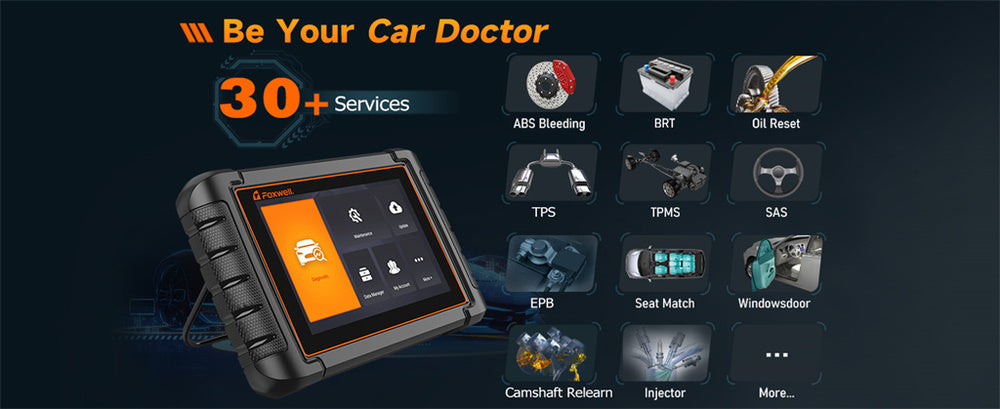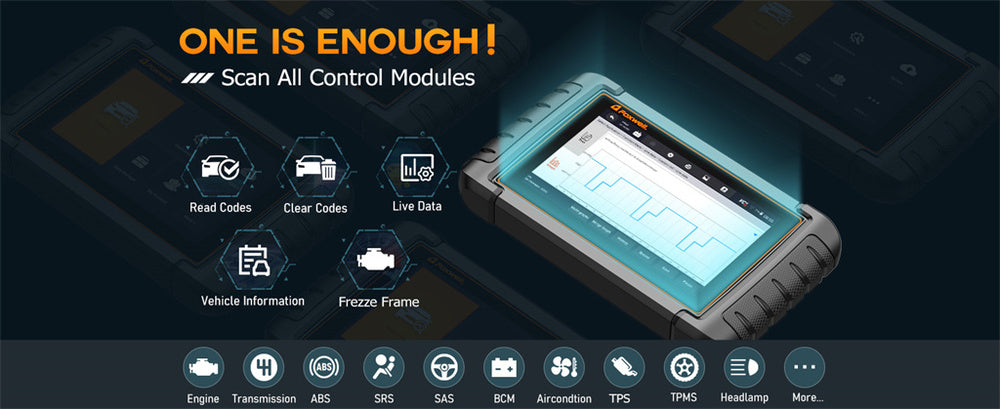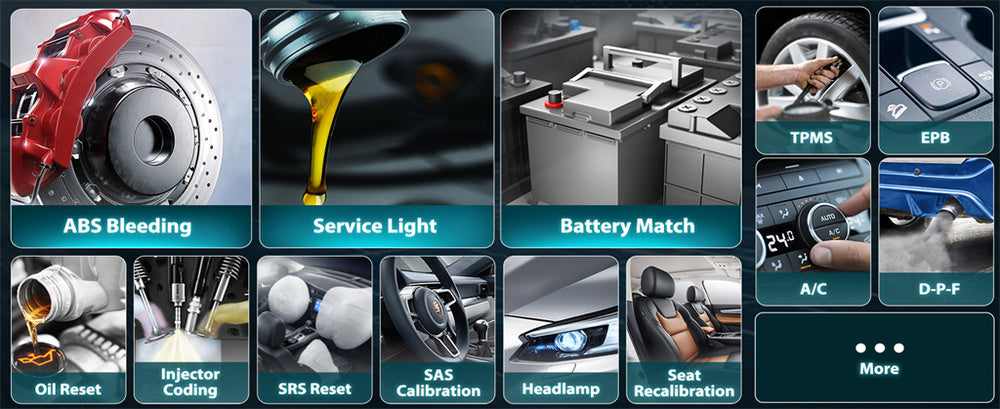Most standard OBD2 scanners can’t read airbag (SRS) codes. You need a specialized scanner designed for SRS codes. These tools don’t just read airbag codes—they also provide detailed fault info to help you accurately diagnose and fix the issue.
One such example is the Foxwell NT716. This scanner is specifically designed to read SRS codes, offering comprehensive diagnostics for various vehicle systems, including airbags. It’s a reliable tool for both professional mechanics and DIY enthusiasts looking to maintain their vehicle's safety systems.
What Scanner Can Read Airbag Codes?

Not all scanners can read airbag codes. Standard OBD2 scanners typically only read engine and transmission codes. To read airbag codes, you need an advanced scanner, These devices are specifically designed to read codes from various systems, including the airbag system.
To read airbag (SRS) codes, a scanner needs to have specific features and capabilities that go beyond the basic functionality of standard OBD2 scanners. Here’s what you should look for:
SRS System Compatibility
Specialized Software: The scanner must have the capability to communicate with the Supplemental Restraint System (SRS) of the vehicle. This requires specialized software that can access and interpret the codes specific to the airbag system.
Firmware Updates: Ensure the scanner can receive regular firmware updates to stay compatible with the latest vehicle models and their SRS systems.
Enhanced Diagnostic Functions
Full-System Diagnostics: The scanner should offer diagnostics beyond the engine and transmission systems. This includes the ability to read, interpret, and clear codes from the SRS system.
Live Data Streaming: The ability to view real-time data from the airbag system sensors can help in diagnosing issues more precisely.
Comprehensive Vehicle Coverage
Wide Range of Makes and Models: The scanner should support a broad range of vehicle makes and models. This ensures it can be used across different brands and types of vehicles, both domestic and international.
Manufacturer-Specific Codes: The ability to read manufacturer-specific codes is crucial for accurate diagnostics. This includes not just generic OBD2 codes but also the specific codes generated by the vehicle’s SRS system.
User-Friendly Interface
Intuitive Display: A clear, easy-to-read display helps users quickly understand the diagnostic information. This includes detailed descriptions of the fault codes and possible fixes.
Guided Diagnostics: Some advanced scanners offer step-by-step guides to diagnose and fix the issues indicated by the fault codes.
Advanced Features
Bi-Directional Control: This feature allows the scanner to send commands to the vehicle’s SRS system for more in-depth diagnostics and testing.
ECU Programming: Some high-end scanners offer ECU programming capabilities, allowing for updates and changes to the vehicle’s software.
How Do I Know if My Airbag Sensor Is Bad?
Wondering if your airbag sensor is acting up? Here’s how to tell:
Airbag Warning Light
First off, keep an eye on your dashboard. The most obvious sign that your airbag sensor might be bad is if the airbag warning light comes on. You know, that little light that looks like a person sitting with a big balloon in front of them? If that light stays on or flashes, it's usually a sign that something’s wrong with the airbag system, often due to a faulty sensor.
Error Codes
Another way to check is by using a diagnostic scanner. If you have one of those advanced scanners that can read SRS codes, you’re in luck. Plug it in, and it will spit out error codes that tell you exactly what's wrong. Look for codes like B1100, B1102, or B1103—these are commonly associated with airbag sensor issues. If you’re not sure what the codes mean, there’s always Google or the scanner’s manual.
Physical Inspection
Sometimes, you need to get a bit hands-on. Inspect the airbag sensors themselves. These are usually located in the front bumper, near the radiator, or inside the passenger compartment. Check for any visible damage, corrosion, or loose connections. It’s a bit like playing detective—look for anything that seems out of place.
Performance Issues
Lastly, be aware of how your airbags behave. While this is harder to test without actually being in an accident (which we definitely don’t recommend), a bad sensor can lead to delayed deployment of the airbags during a collision. This is super dangerous and needs immediate attention. If you’ve been in a minor fender-bender and the airbags didn’t deploy, it’s a sign that something might be off.
Steps to Diagnose a Bad Airbag Sensor
Connect a Diagnostic Scanne
Use an advanced diagnostic scanner that can read SRS codes. Basic OBD2 scanners won’t cut it. Connect the scanner to the OBD2 port (usually under the dashboard), turn on the ignition (but don’t start the engine), and follow the scanner’s instructions to retrieve the SRS codes.
Interpret the Codes
Once you have the codes, refer to the scanner’s manual or an online database to figure out what each code means. This will help you determine if the issue is with the airbag sensor.
Inspect the Sensor and Connections
Look for any obvious signs of damage or disconnection. This includes checking the physical condition of the sensors and their mounting points. Make sure all electrical connectors are secure and free from corrosion. Unplug and replug the connectors to ensure a good connection.
Test the Sensor
If you have access to a multimeter, you can test the sensor’s resistance. Refer to the vehicle’s service manual for the correct resistance values. If the sensor is out of specification or shows no continuity, it needs to be replaced.
Professional Assistance
If you’re unable to diagnose the problem yourself, it’s best to seek help from a professional mechanic. They have the specialized tools and expertise to accurately diagnose and fix airbag system issues. Never ignore airbag warning lights or signs of sensor failure, as they are critical for your safety in the event of an accident.
By following these steps and paying attention to the warning signs, you can determine if your airbag sensor is bad and take the necessary actions to ensure your vehicle's safety systems are functioning correctly.
How Do You Check Airbag Codes?
Checking airbag codes involves using an advanced diagnostic scanner capable of reading codes from the Supplemental Restraint System (SRS). Here’s a step-by-step guide to help you through the process:
Step-by-Step Process to Check Airbag Codes
Gather Necessary Tools
Diagnostic Scanner: Make sure you have an advanced scanner capable of reading SRS codes.
Vehicle Service Manual: This can provide specific information about the location of the OBD2 port and details about the airbag system.
Locate the OBD2 Port
Find the Port: The OBD2 port is usually under the dashboard, near the steering wheel. In some vehicles, it may be hidden behind a panel or cover.
Consult Manual: If you can’t find it, refer to your vehicle’s service manual or look for online guides specific to your car model.
Prepare the Vehicle
- Turn Off the Engine: Make sure the engine is off before connecting the scanner.
- Ignition Position: Insert the key and turn it to the "On" position without starting the engine. This powers up the vehicle’s electrical systems, including the SRS.
Connect the Diagnostic Scanner
- Plug in the Scanner: Insert the scanner’s connector into the OBD2 port securely.
- Power On the Scanner: If necessary, turn on the scanner. Some models may power up automatically when connected.
Navigate the Scanner Menu
- Select Vehicle Make and Model: Enter the required information about your vehicle to ensure accurate diagnostics.
- Choose SRS System: From the scanner’s menu, select the SRS (airbag) system. This option might be labeled differently depending on the scanner (e.g., Airbag, Safety Restraint System).
Read the Airbag Codes
- Initiate Scan: Follow the prompts on the scanner to begin the scan of the SRS system.
- Retrieve Codes: The scanner will communicate with the vehicle’s SRS system and display any stored fault codes.
- Note the Codes: Write down the codes or use the scanner’s memory function to save them. Each code usually comes with a brief description of the issue.
Interpret the Codes
- Refer to Manual: Use the vehicle’s service manual or the scanner’s built-in code library to interpret the codes. This will help you understand the specific issues related to the airbag system.
- Research Online: For more detailed information, look up the codes online. Many automotive websites and forums have extensive databases of diagnostic trouble codes (DTCs).
Clear the Codes
- Fix the Issue First: Before clearing any codes, make sure to address the underlying issue. Clearing codes without fixing the problem can result in the airbag light coming back on.
- Clear Codes: If the problem is fixed, use the scanner to clear the codes. This is usually done through the scanner’s menu by selecting the option to clear SRS codes or reset the system.
Verify the Fix
- Re-scan the System: After clearing the codes, perform another scan to ensure no new codes appear.
- Check Airbag Light: Make sure the airbag warning light on the dashboard is off. If it remains on, there may be additional issues that need to be addressed.
Tips for Effective Diagnosis
- Regular Updates: Keep your diagnostic scanner’s software up to date to ensure compatibility with new vehicle models and systems.
- Professional Help: If you’re unsure about interpreting the codes or fixing the issues, consider consulting a professional mechanic.
By following these steps, you can effectively check and diagnose airbag codes, helping to maintain the safety and functionality of your vehicle’s airbag system.
Will an Airbag Light Clear Itself?
No, an airbag light typically won’t clear itself. Here’s why and what you need to do to clear the airbag light:
Why the Airbag Light Stays On
Persistent Fault Codes
- Stored Fault Codes: When there’s an issue with the airbag system, the vehicle’s onboard computer (ECU) stores a fault code and triggers the airbag warning light on the dashboard. This light indicates a problem that needs attention.
- Manual Reset Required: Even after the underlying issue is resolved, the fault codes stay stored in the ECU’s memory. These codes need to be manually cleared using a diagnostic scanner.
Safety Precaution
- Driver Notification: The airbag warning light is a crucial safety feature. It alerts the driver to potential issues with the airbag system, ensuring the driver is aware of any problems that could affect the deployment of the airbags in a collision.
- System Verification: The light will stay on until the system is verified as fully operational again. This requires checking and clearing the codes, confirming all components are functioning correctly.
How to Clear the Airbag Light
Diagnose the Problem
- Use a Diagnostic Scanner: Connect an advanced diagnostic scanner capable of reading and clearing SRS codes to your vehicle’s OBD2 port. Follow the instructions to read the specific fault codes.
- Identify the Issue: Interpret the fault codes to determine what caused the airbag light to come on. Common issues include faulty sensors, wiring problems, or issues with the airbag module itself.
Fix the Problem
- Repair or Replace Faulty Parts: Address the specific issues identified by the diagnostic scanner. This might involve repairing wiring, replacing sensors, or fixing other components of the airbag system.
- Professional Assistance: If you’re not experienced with vehicle repairs, it’s best to seek help from a professional mechanic to ensure the problem is correctly fixed.
Clear the Fault Codes
Use the Scanner: After repairing the issue, use the diagnostic scanner to clear the stored fault codes from the ECU. This is usually done through the scanner’s menu by selecting the option to clear SRS codes or reset the airbag system.
Confirm the Light is Off: After clearing the codes, check the dashboard to ensure the airbag warning light is no longer illuminated. This indicates the system is now functioning correctly.
When the Light Won’t Turn Off
- Persistent Issues: If the airbag light remains on after clearing the codes, there may be unresolved issues with the system. Re-scan the vehicle to check for any new or remaining fault codes.
- Further Inspection Needed: Persistent warning lights may require further inspection and diagnostics, potentially involving more advanced tools or professional service.
By understanding that the airbag light won’t clear itself and following the proper steps to diagnose and fix the issue, you can ensure the safety and reliability of your vehicle’s airbag system.

Conclusion
Most standard OBD2 scanners can't read airbag (SRS) codes; you need a specialized scanner like the Foxwell NT716. If your airbag warning light is on, use an advanced scanner to diagnose and clear the codes. Remember, the light won't turn off by itself—you need to manually clear the codes after fixing the issue. Address airbag problems promptly to ensure your vehicle's safety.
FAQ:
Can an OBD2 scanner read airbag codes?
Yes, but not all OBD2 scanners can read airbag codes. Check your scanner's specifications.
What type of OBD2 scanner do I need for airbag codes?
You need an advanced or professional OBD2 scanner that includes airbag code reading capabilities.
Why can't all OBD2 scanners read airbag codes?
Basic OBD2 scanners focus on engine and emission-related codes, while advanced ones cover more systems.




Leave a comment
This site is protected by hCaptcha and the hCaptcha Privacy Policy and Terms of Service apply.